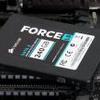What is SATA 3 (6G) ? - 1x nm NAND - MLC
SATA 3 (6G) Explained
SATA 6G (SATA 3), the latest revision of your SATA storage unit connectors, will increase the bandwidth on the SATA controller from 3 GBit/sec towards 6 GBit/sec. For a regular HDD that is not really very important. But with the tremendous rise of fast SSD drives this really is a large plus. Typically we get 3000 Mbit/s : 8 = 375 MB/sec bandwidth minus overhead, tolerances error-correction and random occurrences. SATA 3 is doubling it up, as such we get 6000 Mbit/sec : 8 = 750 MB/sec (again deduct overhead, tolerances error-correction and random occurrences) of available bandwidth for your storage devices. As you can understand, with SSDs getting faster and faster that's just a much warmed and welcomed increase of bandwidth. Put Sata III in RAID and you'll have even more wicked performance at hand. Most motherboards offer only two ports per controller though, so you are (for now) limited to RAID 0 and RAID 1 (stripe or mirror). Also there are two controllers currently being used for mainstream, currently the Sandy Bridge, Ivy Bridge and Haswell platforms offer the highest performing solution. Though still fast, any platform using the Marvell 9128 or 9130 will see lower performance scores as the Marvell controllers use a PCI-Express Gen2 x1 lane interface to the system which restricts performance a little. The internal processor in that chipset also limits IOPS by the way.
What Is A P/E Cycle ?
A program-erase cycle is a sequence of events in which data is written to solid-state NAND flash memory cell (such as the type found in a so-called flash or thumb drive), then erased, and then rewritten. Program-Erase (PE) cycles can serve as a criterion for quantifying the endurance of a flash storage device. Flash memory devices are capable of a limited number of PE cycles because each cycle causes a small amount of physical damage to the medium. This damage accumulates over time, eventually rendering the device unusable.
The number of PE cycles that a given device can sustain before problems become prohibitive varies with the type of technology. The least reliable technology is called multi-level cell (MLC). Enterprise-grade MLC (or E-MLC) offers an improvement over MLC; the most reliable technology is known as single-level cell (SLC). Some disagreement exists in the literature as to the maximum number of PE cycles that each type of technology can execute while maintaining satisfactory performance. For TLC and MLC, typical maximum PE-cycle-per-block numbers range from 1,500 to 10,000. For E-MLC, numbers range up to approximately 30,000 PE cycles per block. For SLC, devices can execute up to roughly 100,000 PE cycles per block.
MLC VS. SLC
At the beginning, memory cells stored just a single bit of information. However, the charge on the floating gate can be controlled with some level of precision, allowing to store more information than just 0 and 1. Basing on such assumption the MLC (Multi Level Cell) memory came to exist. To distinguish them, the old memory type was called SLC - Single Level Cell. The decision of choosing between SLC or MLC is driven by many factors such as memory performance, number of target erase/program cycles and level of data reliability. The MLC memory endurance is significantly lower (around 10,000 erase/program cycles) comparing to SLC endurance (around 100,000 cycles).
So What About That New 1x & 2x nm NAND Lifespan?
New <= 25nm NAND FLASH memory was introduced, designed to be cheaper. The overall lifespan of the ICs has been reduced from 10,000 towards 5,000 program/erase cycles and now at 2,500 P/E cycles. As drastic as that sounds, it's all relative as this lifespan will very likely last longer than any mechanical HDD. Drive wearing protection and careful usage will help you out greatly. With an SSD filled normally and very heavy writing/usage of say 10 GB data each day 365 days a year, you'd be looking at roughly 22 full SSD write cycles per year, out of the 3000 (worst case scenario) available. However, all calculations on this matter are debatable and theoretical as usage differs and even things like how much free space you leave on your SSD can affect the drive.
I've been monitoring the usage myself. The latest NAND partition of TLC and MLC offer at the very least 2,500 P/E cycles. To give you an idea, on my main work system I use 4 P/E cycles per month. If we take 2,500 P/E cycles before cells start to die then 4x12= 48 P/E cycles per year. 2,500 P/E cycles divided by 48 P/E cycles per year could mean a life span of 52 years, but it will depend on how much you write / your workload and stress you put on the SSD.

